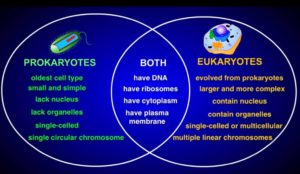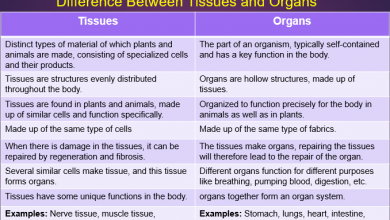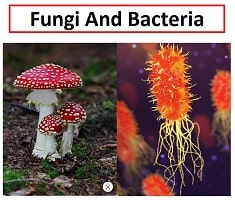What Is The Differences Between Prokaryotic And Eukaryotic Cells
We explain that what is the difference between eukaryotic and Prokaryotic cells? with definition, characteristics, classification and comparison table to better understand.
The cell is the smallest unit of life , and is a fundamental component to define us as living beings. Because it is so small, it was not discovered until the microscope was invented.
It is from the XIX and XX that the cell theory develops, which explains that the cell is the structural unit of living beings and affirms that all living beings are made up of one or more cells. It is also considered a functional unit, as it carries out all vital functions (nutrition, relationship and reproduction). Also, the cell is the genetic unit, which contains the hereditary material and all come from another pre-existing cell.
In this article you will find explained the main differences that exist between prokaryotic and Eukaryotic cells .
The Eukaryotic cell has a membrane that encloses the nucleus, separating it from the cytoplasm. The Prokaryotic cell does not have structures with membranes inside, that is, its intracellular content is scattered in the cytoplasm.
All living beings are made up of cells that, depending on their structure, can be eukaryotic or prokaryotic. The French naturalist, zoologist and biologist Édouard Pierre Léon Chatton (1883-1947) was the first to distinguish between eukaryotic organisms, those with cells with a nucleus, and prokaryotes, which are enucleated.
What Is A Eukaryotic Cell?

The eukaryotic cell is the building block of life for protozoa, fungi, plants, and animals. It is characterized by keeping its genetic material packed within a membrane, forming the nucleus. It also has other intracellular structures surrounded by membranes, known as organelles: mitochondria, vesicles, chloroplasts, among others.
The word “eukaryote” comes from the Greek eu , which means “true” and karyon , which means “nut or kernel.” The eukaryotic cell is the basis for the classification of organisms within the Eukarya domain .
Characteristics Of Eukaryotic Cells
- Varied shapes: depending on the environment where the cell is located, it can be spherical, cubic, pyramidal, flat or starry.
- Varied sizes: eukaryotic cells can measure from 10 µm (like lymphocytes), to 100 µm (like adipocytes or fat cells).
- Varied functions: although eukaryotic unicellular beings, like parasites, must perform all the necessary functions for their survival, in multicellular beings there are cells with different functions. For example, cells in the intestine are designed to absorb nutrients and deliver them to the blood, from where they are distributed. Plant root cells absorb nutrients and water from the soil.
- Presence of organelles: Within the eukaryotic cell are structures specialized in specific functions, which include chloroplasts, the Golgi apparatus, mitochondria, vesicles and lysosomes.
Classification Of Eukaryotic Cells
There are two large groups of eukaryotic cells: the animal cell and the plant cell. A special case is achieved in the cells of fungi, which share characteristics of both animal and plant cells.
Animal Cell
The animal cell has a plasma membrane, nucleus and cytoplasm. Genetic material is stored within the nucleus and is composed of the nucleoplasm and the nuclear envelope. Most of the chemical reactions necessary for the proper functioning of the cell take place in the cytoplasm.
Animal cells have a plasma membrane composed of lipids and proteins, which is the barrier that prevents or allows the entry and exit of compounds into the cell. As the animal cell does not carry out photosynthesis, it does not have chloroplasts. Nor does it have a cell wall, like the plant cell.
Characteristic examples of animal cells are neurons in the nervous system, leukocytes in the immune system, eggs, and sperm in the reproductive system.
Plant Cell
Like the animal cell, it has a differentiated nucleus, membrane, and cytoplasm. However, the plant cell contains chloroplasts , structures that are responsible for the process of photosynthesis.
Thanks to photosynthesis, plants absorb energy from the sun and capture carbon dioxide to synthesize organic compounds and release oxygen into the atmosphere.
In addition, plant cells have a cell wall, an external structure that covers the plasma membrane. The cell wall supports and protects the cell, while allowing intercellular communication.
Cells of fungi are eukaryotic and share common characteristics with animal and plant cells:
- They have a cell wall like plant cells, whose chemical composition (chitin) varies depending on the species.
- They do not photosynthesize, so their cells do not have chloroplasts, like the animal cell.
What Is A Prokaryotic Cell?

The prokaryotic cell is a simple organism composed of membrane and cytoplasm, lacking a nucleus and also lacking organelles like eukaryotic cells (mitochondria, chloroplasts and endoplasmic reticulum). In addition, it has a cell wall that supports the cell.
The word “prokaryote” comes from the Greek pro , which means “before”, and karyon , which means “nut or kernel.” Metabolic reactions in prokaryotic cells are scattered throughout the cytoplasm. They can be autotrophic (like cyanobacteria) or heterotrophic (like lactobacilli).
Characteristics Of Prokaryotic Cells
- Varied shapes: prokaryotic cells can be spherical (as in staphylococci), cylindrical (such as Escherichia coli ), spiral (such as Helicobacter pylori ), or curved (such as Vibrio cholerae ).
- Varied sizes: prokaryotic cells are smaller, they can measure from 0.1 µm like mycoplasmas, to 20.0 µm like Treponema pallidum, the causative agent of syphilis.
- Presence of cell wall: the cell membrane is surrounded by the cell wall composed of peptidoglycan, a characteristic polymer of bacteria.
- Presence of capsule: some bacteria have a mucous layer on the outside, known as a capsule.
Classification Of Prokaryotic Cells
Biologically, they can be classified into two main groups: archaea and bacteria.
Arches
The archaea belong to the Archaea domain . These cells are microscopic and are surrounded by a cell wall, composed of a pseudopeptidoglycan, which protects them and gives them greater resistance. They are found in marine and terrestrial environments, being able to survive under extreme environmental conditions where other living beings do not survive. For this reason they are given the adjective of extremophiles.
Examples of archaea are Methanothermus fervidus , which lives in hot springs (97ºC) and Methanobacterium thermoaggregans , which produces methane and lives at 65ºC.
Bacteria
Bacteria belong to the Bacteria domain . Its cell wall is composed of peptidoglycans and has ester-type lipids. Unlike archaea, bacteria can produce spores and some photosynthesize.
Examples of bacteria are Helicobacter pylori , the causative agent of gastric ulcers, and the yogurt-producing bacteria, Lactobacillus bulgaricus and Streptococcus thermophiles.

Different Types Of Cells
Therefore, a cell can be defined as the structural, functional and genetic unit of all living beings, and it can be classified in different ways. Mainly in prokaryotic (or prokaryotic) and eukaryotic (or eukaryotic) cells. The latter, in turn, can be classified into animal and plant cells , although protozoa, algae and fungi are also eukaryotic organisms .
The two large groups of cells (prokaryotes and eukaryotes) show similarities and differences. The former are unicellular organisms, lacking a defined or true cell nucleus and in which DNA is dispersed throughout the cytoplasm . They are bacteria. Eukaryotes are organisms composed of cells that have a true nucleus, delimited within a double lipid layer, and with organized cytoplasm.
Similarities Between Prokaryotic and Eukaryotic Cells
While prokaryotic and eukaryotic cells are different in many ways, they also exhibit certain similarities. Both contain genetic material, that is, DNA. They have a cell membrane that covers them. Their basic chemical structures are similar , both being made up of carbohydrates, proteins, nucleic acid, minerals, fats, and vitamins.
Both prokaryotic and eukaryotic cells contain ribosomes, which make proteins . The two types of cells regulate the flow of nutrients and waste matter into and out of cells. They also reproduce, although in different ways. They need energy to survive, they contain cytoplasm inside cells and a cytoskeleton. Both classes of cells have a lipid bilayer, known as the plasma membrane, that forms the boundary between the inner and outer side of the cell.
Differences Between Animal And Plant Cells
Within the different types of eukaryotic cells we can find animal and plant cells, which although they show some similarities, are also different in some aspects.
As for shared characteristics , they both have a well-defined nucleus, where they house DNA. They also carry out similar production processes, which include mitosis and meiosis. Cellular respiration is necessary for energy, and they share some cellular components (Golgi apparatus, endoplasmic reticulum, ribosomes, etc.)
In reference to the differences, plant cells store energy in the form of starch , while animal cells do so in the form of glycogen. The former tend to be larger than the latter, and are usually rectangular in shape. Although both have a cell membrane, the cell wall is only present in plant cells, algae, archaea and fungi. Plant cells are capable of synthesizing all essential amino acids, something that is not the case with animal cells.
Main Differences Between Prokaryotic And Eukaryotic Cells
There are also certain differences between prokaryotic cells and eukaryotic cells. Scientists believe that eukaryotic cells evolved from prokaryotic cells.
But what are these differences? In the following lines we explain them to you.
1. Core
While eukaryotic cells have a well-defined nucleus, prokaryotes do not. Genetic information is stored within the nucleus of eukaryotes .
2. Origin
It is estimated that prokaryotic cells have their origin around 3.7 billion years, whereas eukaryotic cells 2 billion years.
3. Size
Prokaryotic cells are smaller : 0.1–5.0 µm in diameter. The largest eukaryotes: 10-100µm in diameter.
4. Cell organization
Prokaryotic cells are usually unicellular, while eukaryotic cells are multicellular.
5. Genetic material
The genetic material of eukaryotes is stored in the nucleus; however, in the case of prokaryotic cells, it is dispersed throughout the cytoplasm. The DNA of prokaryotic cells does not associate with histones.
6. Composition of the plasma membrane
In eukaryotic cells, plasma membranes contain sterols . In the case of prokaryotic cells, only in mycoplasmas.
7. Form of genetic material
In prokaryotic cells, DNA is circular. Now, when it comes to eukaryotic cells, DNA is linear and, as mentioned above, it is associated with histone proteins.
8. Number of chromosomes
Prokaryotic cells have only one chromosome. However, eukaryotic cells have multiple chromosomes .
9. Plasma membrane
In prokaryotic cells the plasma membrane is composed of peptidoglycan or murein. In the case of eukaryotes, it is made up of phospholipids.
10. Organizers
Prokaryotic cells have an interior matrix with nonmembranous organelles . Prokaryotic cells present in the cytoplasm membranous organelles (for example, Golgi apparatus).
11. Reproduction
Reproduction in prokaryotic cells occurs by asexual reproduction, by binary fission. In contrast, in eukaryotic cells, reproduction occurs by mitosis and meiosis .
12. Living organisms
Prokaryotic cells are bacteria , while prokaryotic cells are part of animals, plants, fungi, protozoa, and algae.
Comparison Chart: Difference Between Prokaryotes And Eukaryotes Cells
| Prokaryotic cell | Eukaryotic cell | |
|---|---|---|
| Definition | Cell without a defined nucleus, its genetic material is scattered in the cytoplasm. | Cell with a nucleus defined by a membrane that contains the genetic material. |
| Size | Between 1 and 10 microns. (Little) | Between 10 and 100 microns. (Big) |
| Shape | It can be spherical, cane, orthographic comma, or spiral. Although they are unicellular, they can form colonies. | Very varied, they can constitute unicellular or multicellular organisms. |
| Parts | Cell wall Membrane Cytoplasm |
Cell membrane Cytoplasm Nucleus |
| Genetic information | Located in a nucleoid, without being surrounded by a membrane. | DNA and proteins form the chromatin that is concentrated in the nucleus |
| Cellular division | Direct, mainly by binary fission. There is no mitotic spindle or microtubules. | By mitosis and meiosis. Presents mitotic spindle, or some form of microtubule arrangement. |
| Genes | Expressed in groups called operons. | Individually expressed; they have introns and exons. |
| Ribosomes | Present but small (70S) | Present and great (80S) |
| Flagellum | Simple, formed by the flagellin protein. | Composite, consisting of tubulin and other proteins. |
| Chromosomes | Single circular chromosome. | Multiple. Each with two chromatids, centromere and telomeres. |
| Cellular wall | Present | Only present in plants and fungi. |
| Domains | Bacteria and Archaea | The Eukarya domain that groups plants, animals and fungi. |
| Core surrounded by membrane | No | Yes |
| Nucleolus | Absent | Present |
| Endoplasmic reticulum | Absent | Present |
| Golgi apparatus | Absent | Present |
| Organelles | Absent | Present |
| Microtubules | Absent | Present |
| Microfilaments | Absent | Present |
| Intermediate filaments | Absent | Present |
| Exocytosis and endocytosis | Absent | Present |
| Cell division mode | Cell fission | Mitosis and meiosis |
| Genetic information | Present in an area called the nucleotide. the | DNA bound to proteins, histones with which they form chromosomes |
| RNA processing | Little | Multiple |
| * Ribosomes | Little | Big |
| Examples | Staphylococcus aureus bacteria , the archaea Halobacterium salinarum. | The yeast Saccharomyces cerevisiae, the fruit fly Drosophila melanogaster , the banana Musa sp . |


